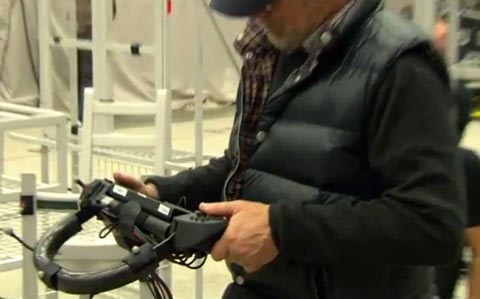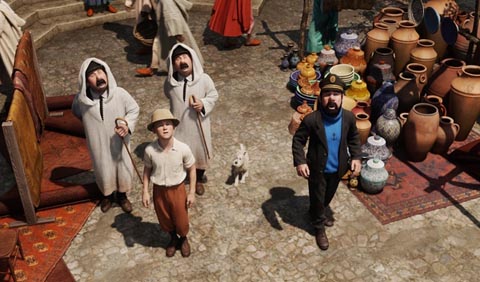

“Tintin” Ushers in a New Era of Photoreal Cartoons

This is not a review of the Adventures of Tintin. I think we can all agree there have been enough of those already. My primary interest in checking out Tintin was to see the animation approach taken by Steven Spielberg and New Zealand animation studio Weta (as well as Giant Studios, which handled the motion capture recording). These two studios are at the cutting edge of exploring new forms of character animation, and Tintin has proven to be an important stepping stone in the development of our art form. To my eyes, it’s the first successful example of “photoreal cartooning.” By successful, I don’t mean perfect, but rather that the technology no longer disrupts the overall viewing experience. It takes a generous imagination to see where the technologies in Tintin are headed, but think back to the creepy baby in John Lasseter’s Tin Toy. It took less than twenty years for CG character animation to evolve from a deformed lopsided infant into the most common feature animation filmmaking technique.
To be honest, it’s hard for me to judge the animation in Tintin. Photorealistic cartooning–which some will argue is an oxymoron–makes even keyframed CG animation look traditional. Many will say it isn’t even animation. The confusion is understandable. Animation is evolving so rapidly before our eyes that we can barely keep pace with these changes. We desperately try to apply old labels and definitions and find them insufficient. Still, Tintin at its core is pure animation created frame by frame. True, it was augmented by other processes, but the end result was achieved distinctly through frame-by-frame techniques. And if the mark of a true piece of animation art is the director’s control over every element within the frame, then never has this been truer than in Tintin.
Motion capture is a flexible technique that can be stretched in multiple directions. James Cameron used it in Avatar to mimic the performance of live actors. Ironically, Cameron had to employ a team of animators to tweak and mold the motion capture data to achieve greater realism. The technology cannot yet accurately record the nuances of human behavior without the intervention of animators.
Spielberg, on the other hand, appears to have made animators a more integral part of the creative process. Instead of demanding that the animators make the motion capture data look more realistic, he allowed them a degree of freedom. In this LA Times interview, he explained, “I can underwrite or overwrite a performance and through the animators put [something into a performance] that even the actors didn’t bring to the bay.” In that quote, Spielberg acknowledges that the actor is not the be-all, end-all of the motion capture process (much to Andy Serkis’s dismay I’m sure) and that animators play a role in creating the performance, much as in traditional animation.
Spielberg’s attempt to marry motion capture and animation is a step forward, but not entirely successful. The photorealism of the design jars with the disturbingly wacky behavior of the characters. Watching a pliable, squash-and-stretch cartoon character like Daffy Duck wrapped up in a spinning plane propeller and spit out is funny; watching the photoreal Captain Haddock perform that same gag in Tintin looked awkward and uncomfortable. This discordance between design and performance will be ironed out when the technology is placed in the hands of experienced animation directors who more fully understand how the medium works.
There’s another component to Tintin that’s been largely overlooked and it’s this:

Producer Peter Jackson explained what Spielberg is doing in the photo:
For [Tintin] we wanted to create a virtual studio — we haven’t even got a name for it — where Steven would be able to pick up a virtual camera that looks a little like a PlayStation controller with a six-inch screen and use it to step inside the world of Tintin that we had created. All the locations had to be built in advance of us doing the motion-capture shoot, as it were; so for the best part of two or three years we were building all of the sets, all of the cars, all the airplanes, everything in the film was constructed but then the key thing was to break away from all of the technical restraints and make it as much a live-action experience as we could.
This is a transformative concept, much like 3-D was hyped as being, except this is the real deal. Whereas animation in the past was a labor-intensive process, and each scene was carefully laid out from a single angle that was drawn by the layout artist. Even as we moved to computer-generated imagery, artists were careful not to overreach the boundaries of their world. Brad Bird told me how he stayed on budget on The Incredibles by carefully selecting shots in the storyboard/animatic stage and not modeling the world beyond the confines of those preselected shots.
To open up the entire world to the animation filmmaker creates a tantalizing array of possibilities. It is a paradigm shift in animation production that pushes it closer to the world of the live-action camera, while still remaining firmly entrenched in the realm of cartoon fantasy. The technology also raises interesting questions. For example, if a director is selecting all his shots via a specialized hand-held controller, what could that potentially do to the role of the previz/layout artist? These roles won’t disappear anytime soon, but the job descriptions must undergo an evolution. The “virtual studio” approach will mean more planning upfront and more work for people who have to design and build the worlds, but less control over the finished film for the layout artists.
The limitations of the filmmaking-by-controller approach are evident in Tintin. Spielberg is trapped in a videogame of his own making and can’t stop exploring the world long enough to tell a story. Knowing when to exercise restraint will become even more crucial in this new mode of animation production. Whenever I see the incessant camera moves in animated films today, I’m reminded me of something that French animation director Michel Ocelot told me over dinner a couple years ago. Michel abhors camera pans and trucks. He feels that camera movements pull the viewer out of the story, and he prefers a static screen as much as possible. His austere minimalism may seem archaic, but the argument for Ocelot’s point of view would be the pirate ship battle and the crane-fight finale in Tintin. Despite their nauseating overuse of the camera, both of those scenes lumbered along, failing to elicit any tingle of excitement or adventure. The camera, even in this latest and fanciest iteration, does not compensate for skillful filmmaking.
Many people, including those with whom I saw Tintin, have commented that they have been exhausted after watching the film. Much of that we could presume is due to the repetitive action sequences, but I would also suggest that it was the overwhelming level of graphic detail. There was so much happening that the eye never stopped racing around the screen, in desperate search of a focal point.
Here’s a good example: halfway down this web page, there’s a short scene with Snowy running. Pay attention at the :27 second mark. There’s a guy running across the street for no apparent reason. He may be running because of the oncoming cars, but then why does he look in the opposite direction of where the cars are coming from? To me, it’s emblematic of the entire production: too many artists working on too many individual elements in each scene. There is an inordinate amount of randomness in Tintin and many scenes lacked cohesion or clarity. Audiences may not have been able to pinpoint the randomness but they certainly felt it.
Tintin was, in some ways, exactly what I expected it to be: a typical Spielberg film with hamfisted direction. But it was also surprising and fascinating from a technological point of view. As the animator’s toolset continues to evolve, directors will gain granular control over cartoons in a way that was never possible before. The challenge in the future, as in the past, will be harnessing the technology to work with the artwork instead of against it.
